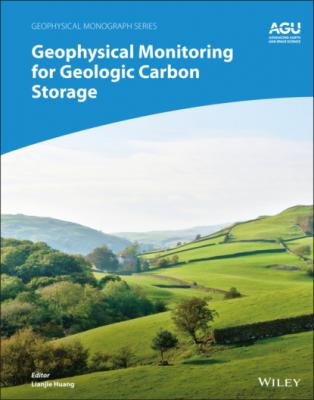Geophysical Monitoring for Geologic Carbon Storage. Группа авторов
Читать онлайн.| Название | Geophysical Monitoring for Geologic Carbon Storage |
|---|---|
| Автор произведения | Группа авторов |
| Жанр | География |
| Серия | |
| Издательство | География |
| Год выпуска | 0 |
| isbn | 9781119156840 |
2.1. INTRODUCTION
Geodetic monitoring, the repeated measurement of displacements and strains, both on the surface and within the interior of the Earth, provides an important class of techniques for assuring the safety of geological storage and for detecting leakage. There are important advantages associated with geodetic methods. The observations are usually gathered frequently in time, from every few minutes to every few months, depending upon the type of data. There are a diverse set of instruments for measuring strain and displacement in various configurations, either on the Earth's surface, at depth, or even from space. Thus, geodetic measurement may often be gather remotely, greatly simplifying data collection and allowing for cost‐effective monitoring, particularly in comparison with more intrusive techniques such as seismic surveys. The Earth often deforms in response to fluid injection, particularly at the volumes and rates associated with the geological storage of carbon dioxide. Therefore, geodetic observations are sensitive to fluid volume and pressure changes and may be used to monitor the fate of injected fluids. The magnitude of surface displacement increases dramatically as the source driving the deformation approaches the surface. Thus, geodetic monitoring is well suited to detecting leakage and the upward migration of fluids under pressure. In this chapter, we will discuss the use of geodetic data for monitoring injected carbon dioxide. Our primary focus will be on space‐based Interferometric Synthetic Aperture Radar (InSAR) as this is perhaps the most cost‐effective geodetic technique for land‐based storage sites.
2.2. OBSERVATIONAL METHODS
2.2.1. Overview
Given its practical applications, geodesy, the measurement of distances and changes in distances (displacements), is probably one of the oldest scientific disciplines. Early leveling work and distance‐measuring techniques involving the use of calibrated rods and chains date back to ancient times and continue to this day, though they have largely been replaced by satellite‐based and laser‐based techniques. Another early technique was the measurement of the local slope, the horizontal gradient of surface elevation, using a calibrated bubble level. This has evolved to modern day, highly accurate, capacitance‐based tilt meters, capable of determining angular changes with nanoradian precision (Wright, 1998), optical fiber‐tilt meters (Chawah et al., 2015), and portable tilt meters and extensometers (Hisz et al., 2013). Advanced tilt meters are now self leveling and may be used in boreholes and on the seabed. Trilateration by a constellation of satellites is the basis for the Global Positioning System (GPS), and Global Navigation Satellite Systems (GNSS) in general. This technology appears in many applications including the monitoring of subsurface fluid flow (Moreau & Dauteuil, 2013). Both tilt and GNSS measurements usually have high temporal resolution, with observations gathered every few minutes or hours (Schuite et al., 2017). However, cost often constrains one to a sparse network of instruments, limiting the spatial resolution of the displacement field. Leveling is similarly restricted to point measurements, typically gathered along roads or other open areas.
There is another class of observation techniques that can best be described as scanning systems. In these devices, propagating waves are reflected off objects of interest and the returns are used to estimate distances. Most commonly, electromagnetic waves are utilized. However, there are also sonar (sound waves) and seismic (elastic waves) systems that are used in particular applications. For example, time‐lapse seismic surveys have been used to extract seismic time strains over deforming reservoirs, a measure of the vertical strain in the subsurface. Such a technique has the advantage that the wave is sensing displacements at depth and even within the reservoir. Such displacements will typically be much larger than surface displacements. Shortly after the invention of the laser, the phase shift of its signal was used to measure changes in distance. Such laser ranging has progressed and is now used over a wide range of scales from engineering applications to airborne LiDAR surveys and even satellites (Eitel et al., 2016) and is useful for mapping geologic hazards (Joyce et al., 2014). Longer wavelength microwave signals are used in InSAR imaging, perhaps the most promising geodetic technology for monitoring the geological storage of carbon dioxide (Massonnet & Feigl, 1998; Rosen et al., 2000; Ferretti, 2014). In the next section, we describe this approach in much more detail. In Field Applications, section 2.4, we illustrate the use of InSAR observations at three storage sites.
2.2.2. SAR Interferometry
Radar sensors, mounted on satellite platforms, airplanes, or even a tripod on the ground, make it possible to measure ground displacement with millimeter accuracy, thanks to a particular technique known as SAR (Synthetic Aperture Radar) interferometry (InSAR) (see Ferretti, 2014, for a comprehensive review). The satellites both send and receive signals, recording the complex returns and using them for both imaging and range (distance) estimation (Fig. 2.1). Unlike optical systems, the sensors operate in the microwave domain, with wavelengths of a few centimeters, 100,000 times longer than those of the visible spectrum. Being an active system, a radar sensor can function 24 hours a day and year‐round, as it can see through clouds, fog, and rain, independent of the Earth's illumination.
An important feature of a SAR system is its ability to record both amplitude and phase information. While the amplitude depends on the amount of energy backscattered toward the sensor, the phase is related to the distance between the phase center of the radar antenna and the target on ground. More precisely, the phase value ϕ of a pixel P of a radar image can be modeled as a mixture of four distinct contributions (Ferretti et al., 2007a):
where ϑ is the phase shift related to the location and to the reflectivity of all elementary scatterers within the resolution cell associated with pixel P. The coefficient
